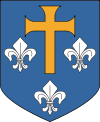Uniejów
| Uniejów | |||
|---|---|---|---|
 | |||
| |||
 Uniejów | |||
| Coordinates: 51°58′12″N 18°48′1″E / 51.97000°N 18.80028°E | |||
| Country |
| ||
| Voivodeship | Łódź | ||
| County | Poddębice | ||
| Gmina | Uniejów | ||
| Government | |||
| • Mayor | Józef Kaczmarek | ||
| Area | |||
| • Total | 12.33 km2 (4.76 sq mi) | ||
| Population (2006) | |||
| • Total | 2,916 | ||
| • Density | 240/km2 (610/sq mi) | ||
| Time zone | CET (UTC+1) | ||
| • Summer (DST) | CEST (UTC+2) | ||
| Postal code | 99-210 | ||
| Car plates | EPD | ||
| Website | http://www.uniejow.pl | ||
Uniejów [uˈɲejuf] is a town in Poddębice County, Łódź Voivodeship, Poland, with 2,960 inhabitants (2004). The town lies in northwestern corner of Poddebice County, near the border with Wielkopolskie Voivodeship. Uniejów is famous for its landscape park (34 hectares (84 acres)), regarded as one of the best preserved and most beautiful parks of central Poland.
History
The history of the town dates back to the early years of Polish statehood. Mentioned as Uneievo in a bull of Pope Innocent II (1136), Uniejów is one of the oldest towns of Poland. At that time it belonged to the Archbishops of Gniezno, and received its town charter most likely before 1290. In the late 13th century, Archbishop Jakub Swinka founded Church of the Holy Spirit, and in 1331, Uniejów was burned by the Teutonic Knights. The town was rebuilt, and in the late 14th - early 15th century, it was a local center of commerce and crafts. For centuries, Uniejów enjoyed several privileges, granted to it by the Archbishops of Gniezno. In 1360-1365, a defensive castle was built here. It became one of residences of the Archbishops, here several councils and meetings took place.
Like many Polish cities, Uniejów declined after Swedish invasion of Poland. The castle was ransacked, and the town itself was burned. There also were two dangerous fires, in 1736 and 1790, and after the Congress of Vienna (1815), the town became part of Russian-controlled Congress Poland, where it remained until World War One. In 1836, Uniejów was granted to a Tsarist General Aleksander Toll, and in 1870, it lost its town charter, becoming a village. In 1919 Uniejow again became a town.
In September 1939, during the Invasion of Poland, Polish units of Poznan Army resisted here the advancing Wehrmacht. During the heavy fighting, Uniejów was partially burned.
Currently, Uniejów is a popular spa and tourist destination, due to its landscape park and geothermal waters. The town has several restaurants, hotel located in the castle, and other amenities. There also are walking and bicycle trails. Among sights are Gothic castle (built in 1360-1365 by Archbishop Jaroslaw of Bogoria and Skotnik, restored in 1956-67), collegiate with a 14th-century Gothic presbytery, neo-Baroque church tower (1901), Classicistic manor house (1845). The village of Spycimierz, with its ancient Slavic gord, lies four kilometres (2.5 miles) away.
External links
| Wikimedia Commons has media related to Uniejów. |
Coordinates: 51°58′N 18°48′E / 51.967°N 18.800°E

